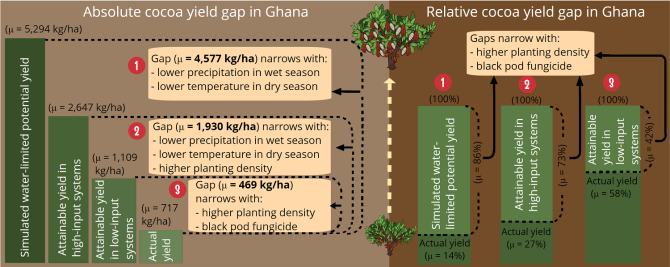
Project
Cocoa-climate-forest Interactions
Climate change is expected to impact negatively on cocoa production. However, eco-physiological response of cocoa tree, effects of elevated atmospheric CO2 concentration & possible adaptations practices have not yet been considered hence effects on production is not sufficiently quantified. This project links cocoa crop modeling, empirical and spatial analysis to identify spatially explicit cocoa-climate-forest interactions to improve understanding of impacts of climate change on cocoa and the effects of possible shifts in production areas on forest cover.
Background
Climate change through warming and shifts in rainfall is expected to impact negatively the production of cocoa at its core origin, West Africa. Impact models have predicted geographic shifts in production areas and a potential loss of about 50% of current climatically suitable areas for growing cocoa by 2050. However, it is unclear how changes in climatically suitable areas will affect cocoa production. Existing methods do not consider the mechanisms underlying growth and production, which are essential to understand for predicting eco-physiological responses of cocoa tree to changing climate. Hence, cocoa yield response to climate change is not sufficiently quantified.
Predicted shifts in production areas could also have serious implications for forest biodiversity and ecosystem services as it may drive producers to new areas which may coincide with forest. It is therefore urgent to recognize how progressive climate change could affect cocoa production and its related risks to forest to ensure long-term prosperity and sustainability.
Research objective
The objective of this project is to (1) improve understanding regarding impacts of climate change on cocoa; and (2) to predict implications for cocoa production in West Africa, including possible shifts in production areas on forest cover. Specifically, to
- Improve understanding of how climate currently influences cocoa yields and the role of management.
- Quantify cocoa yield gap & determining factors
- Assess implications of climate change on cocoa production and potential consequences on forested areas
Method
A combined crop modelling, spatial and empirical analysis approaches is used. An improved and extended (including effects of [CO2]) version of an existing cocoa crop model, SUCROS-Cocoa is used to simulate cocoa growth and yields under current and future climate conditions.
Research area
Detailed study is conducted in Ghana due to data availability & the large scale spatial temporal variation in environmental conditions while climate change impacts are assessed for West Africa and Cameroon.
Results
Unravelling drivers of high variability of on-farm cocoa yields across environmental gradients in Ghana.
- Interventions intended to improve yields & climate adaptation requires an understanding of yield drivers at farm level.
- Drivers of cocoa yield & its relevance for farms with different production levels were unraveled with unprecedented dataset.
- Cocoa farms with high yields are more sensitive to environmental conditions than farms with low yields.
- Climate effects on on-farm cocoa yields were stronger than soil effects, but management effects were most important.
- Good agricultural practices need to be in place before investing in additional climate adaptation practices.

The cocoa yield gap in Ghana: a quantification and an analysis of factors that could narrow the gap.
- Increasing cocoa yields per unit area is a means to meet growing demand, secure food security, improve livelihoods and reduce pressure on forest.
- We quantified the cocoa yield gap by comparing water-limited yield, attainable yield in high- & low-input systems with farmer yields in Ghana.
- Considerable yield gaps were found on all cocoa farms but water-limited yield gaps were much larger than attainable in high- and low-input systems.
- Relative yield gaps are substantial, and driven mostly by management practices, cocoa tree density and black pod control.
- Improved agronomic practices offer opportunities to substantially increase production of present-day cocoa plantations.

Publications
-
Drivers of cocoa yield under current and future climates
Wageningen University. Promotor(en): N.P.R. Anten, P.A. Zuidema, co-promotor(en): D.M.A. Rozendaal, E. Rahn - Wageningen: Wageningen University - ISBN: 9789464476088 -
The cocoa yield gap in Ghana: A quantification and an analysis of factors that could narrow the gap
Agricultural Systems (2022), Volume: 201 - ISSN 0308-521X -
Unravelling drivers of high variability of on-farm cocoa yields across environmental gradients in Ghana
Agricultural Systems (2021), Volume: 193 - ISSN 0308-521X